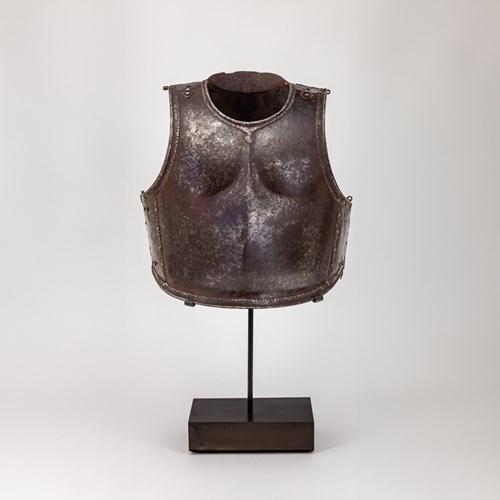Marketplace
A Bronze 'Kettle' Ewer
A Bronze 'Kettle' Ewer
Date Late 16th or early 17th century
Epoque 1400-1600, 1600-1750, 16th Century, 17th century
Origine North India, Deccan
Medium Bronze
Dimension 26 cm (10¹/₄ inches)
The solid cast ewer is of ‘kettle-like form’ and rests on a circular foot with vertical fluted lobed decorated on an onion-shaped bulbous body. The curved serpentine spout is depicted with a stylised dragon-head at the opening. At top of the ewer, there is an arched handle from where the water can be filled from the top opening.
This kettle-shaped ewer characterises examples of an earlier form which is recognised by Mark Zebrowski which evolved during the 15th and 16th centuries in Persia and India. A bronze ewer from Deccan or Iran published in Zebrowski, circa 1600, shares the same onion-like shape as our ewer including a similar arched handle to the top and a curved serpentine spout (see p. 152, pl. 198). A solid cast bronze ewer attributed to South India, of the same form, and which shares a closer resemblance in terms of the spout and fluted body decoration is dated to 17th century or earlier (see Zebrowski, pp. 154-155, pl. 205). There is a similar brass ewer in a Private Collection which is closer in height to our ewer and dates to the 16th century or earlier (see Zebrowski, p. 155, pl. 206). Another ewer of similar form but of cast silver is in The National Museum of Denmark, Accession Number EV2594, which dates to the early 17th century.
Stock no.: A4291
This kettle-shaped ewer characterises examples of an earlier form which is recognised by Mark Zebrowski which evolved during the 15th and 16th centuries in Persia and India. A bronze ewer from Deccan or Iran published in Zebrowski, circa 1600, shares the same onion-like shape as our ewer including a similar arched handle to the top and a curved serpentine spout (see p. 152, pl. 198). A solid cast bronze ewer attributed to South India, of the same form, and which shares a closer resemblance in terms of the spout and fluted body decoration is dated to 17th century or earlier (see Zebrowski, pp. 154-155, pl. 205). There is a similar brass ewer in a Private Collection which is closer in height to our ewer and dates to the 16th century or earlier (see Zebrowski, p. 155, pl. 206). Another ewer of similar form but of cast silver is in The National Museum of Denmark, Accession Number EV2594, which dates to the early 17th century.
Stock no.: A4291
Date: Late 16th or early 17th century
Epoque: 1400-1600, 1600-1750, 16th Century, 17th century
Origine: North India, Deccan
Medium: Bronze
Dimension: 26 cm (10¹/₄ inches)
Literature: Zebrowski, M. Gold, Silver & Bronze from Mughal India, Alexandria Press in association with Laurence King, London, 1997.
Plus d'œuvres d'art de la Galerie









